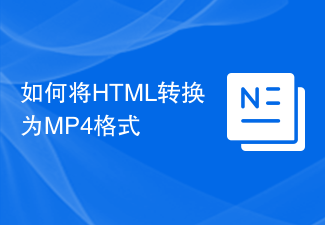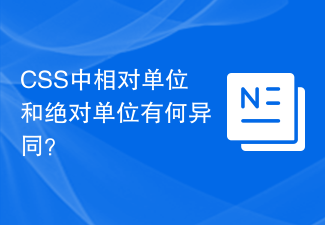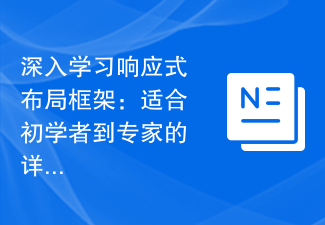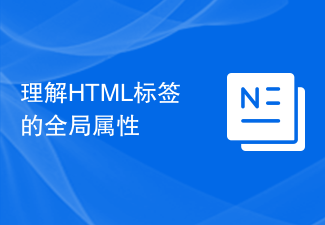
Quickly master the key concepts and usage of HTML global attributes
HTML (Hypertext Markup Language), as a markup language, is used to build web pages. In HTML, global attributes are a set of attributes that apply to all HTML elements and have common concepts and usage. Mastering the key concepts and usage of these global attributes can help us better understand HTML markup and build web pages.
1. The concept of global attributes
Global attributes refer to attributes that can be applied to any HTML element. They are not only used for specific HTML elements or tags. Global properties are similar to properties related to a specific element, but can be used on any element. Global attributes include the following aspects:
- class: Specify one or more class names of HTML elements. Class names can be used to specify the style and behavior of elements. Multiple class names can be separated by spaces.
- id: Specifies the unique identifier of the HTML element. Each id value must be unique within the HTML document and can be used for element references in other languages such as JavaScript.
- style: Define the inline style of HTML elements. You can directly set the style of an element through the style attribute, such as color, font, border, etc.
- title: Specifies additional information for the HTML element, usually displayed when the mouse is hovered. More text information or description can be provided.
2. Usage of global attributes
The following will show the usage of global attributes through specific code examples:
-
Usage of class attributes:
<style> .red-text { color: red; } .bold-text { font-weight: bold; } </style> <p class="red-text">这是一个红色的文本。</p> <p class="bold-text">这是一个加粗的文本。</p> <p class="red-text bold-text">这是一个既红色又加粗的文本。</p>In the above code, the class attribute is used to specify one or more class names, and then add red and bold styles to the text through the CSS style sheet. You can overlay multiple styles by specifying multiple class names in the class attribute.
-
Usage of id attribute:
<p id="my-paragraph">这是一个段落。</p> <script> var paragraph = document.getElementById("my-paragraph"); paragraph.style.color = "blue"; </script>In the above code, the id attribute is used to assign a unique identifier to the paragraph element. Then you can use the getElementById method in JavaScript to get the reference to the paragraph element through the id value, and then operate on it. In this example, we set the text color of the paragraph to blue.
-
Usage of style attribute:
<p style="color: green; font-size: 20px;">这是一个绿色且字体大小为20px的文本。</p>
In the above code, the style attribute is directly embedded in the paragraph tag. You can change the color and font of the text by setting the style attribute. size.
-
Usage of title attribute:
<p title="这是一个特殊的段落。">这是一个段落。</p>
In the above code, the title attribute is used to specify an additional information for the paragraph element, and when the mouse hovers over the paragraph When it is on, it will be displayed.
Summary:
Global attributes are a set of attributes that apply to all elements in HTML. Through the class, id, style and title attributes, we can implement the style and behavior of the elements. control. By mastering the key concepts and usage of global attributes, we can better use HTML to build web pages with good interactivity and visual effects.
The above is the detailed content of Master the key concepts and applications of HTML global attributes. For more information, please follow other related articles on the PHP Chinese website!
 如何将HTML转换为MP4格式Feb 19, 2024 pm 02:48 PM
如何将HTML转换为MP4格式Feb 19, 2024 pm 02:48 PM标题:HTML如何转换为MP4格式:详细代码示例在日常的网页制作过程中,我们常常会遇到将HTML页面或者特定的HTML元素转换为MP4视频的需求。例如将动画效果、幻灯片或其他动态元素保存为视频文件。本文将介绍如何使用HTML5和JavaScript将HTML转换为MP4格式,并提供具体的代码示例。HTML5的video标签和CanvasAPIHTML5引入
 我们如何在所有HTML元素上嵌入自定义数据属性?Aug 28, 2023 pm 12:49 PM
我们如何在所有HTML元素上嵌入自定义数据属性?Aug 28, 2023 pm 12:49 PM在本文中,我们需要在所有HTML元素上嵌入自定义数据属性。我们可以使用HTML中的data-*属性来实现。在HTML中,data-*属性用于自定义仅对网页或应用程序私有的数据。该属性可为HTML元素添加自定义值。HTML中的data-*属性由两部分组成−属性值可以是任意字符串。属性名称应只包含小写字母,并且在前缀"data-"之后必须至少有一个字符。这些数据通常在JavaScript中用于改善用户体验。以下是在HTML元素上嵌入自定义数据属性的示例。示例1在这个例子中,我们已
 JSP文件使用的技巧和注意事项Feb 01, 2024 am 09:15 AM
JSP文件使用的技巧和注意事项Feb 01, 2024 am 09:15 AMJSP文件的打开技巧与注意事项1.使用文本编辑器打开JSP文件JSP文件本质上是文本文件,因此可以使用任何文本编辑器来打开它们。一些流行的文本编辑器包括记事本、记事本++、SublimeText和Atom。2.在IDE中打开JSP文件如果你正在使用集成开发环境(IDE)来开发JSP应用程序,那么你也可以在IDE中打开JSP文件。一些流行的IDE包括Ec
 HTML盒模型的概念及作用Feb 18, 2024 pm 09:49 PM
HTML盒模型的概念及作用Feb 18, 2024 pm 09:49 PMHTML盒模型是一种用于描述元素在网页中布局和定位的概念。它将每个HTML元素包装在一个矩形的盒子中,这个盒子由内容区域、内边距、边框和外边距组成。在编写网页时,了解盒模型对于控制元素的尺寸、位置和样式都非常重要。具体的盒模型示例可以通过以下代码进行演示:
 CSS中相对单位和绝对单位有何异同?Feb 18, 2024 pm 10:07 PM
CSS中相对单位和绝对单位有何异同?Feb 18, 2024 pm 10:07 PMCSS(层叠样式表)是一种用于描述网页上元素样式的标记语言。在CSS中,有两种不同的长度单位,分别是相对单位和绝对单位。相对单位是相对于元素自身或其父元素的大小来计算的。常见的相对单位有:百分比(%)、em和rem。百分比单位是相对于父元素的大小来计算的。例如,如果父元素的宽度为400px,子元素的宽度设置为50%,那么子元素的实际宽度就是200px(400
 HTML全局属性的实际运用场景:5个提升网页开发效率的技巧Feb 18, 2024 pm 05:35 PM
HTML全局属性的实际运用场景:5个提升网页开发效率的技巧Feb 18, 2024 pm 05:35 PMHTML全局属性的实际应用案例:提升网页开发效率的5个技巧HTML作为构建网页结构的标记语言,拥有许多全局属性,它们可以被应用在不同的元素上,用于实现不同的功能和效果。在网页开发过程中,合理地使用这些全局属性可以极大地提高开发效率。本文将为您介绍5个实际应用案例,并附上相应的代码示例。class属性的应用:批量修改样式class属性可以给HTML元素指定
 深入学习响应式布局框架:适合初学者到专家的详尽指南Feb 19, 2024 pm 05:43 PM
深入学习响应式布局框架:适合初学者到专家的详尽指南Feb 19, 2024 pm 05:43 PM响应式布局框架解析:从初学者到专家的必备指南随着移动设备的普及和多样化,响应式布局成为了现代Web设计的必备技能。响应式布局框架以其简单、灵活和可维护的特点,成为了开发者们的首选工具。然而,对于初学者来说,学习和理解响应式布局框架可能会感到有些困惑。本文将从初学者到专家,为您提供一个详细的指南,帮助您掌握响应式布局框架,同时提供具体的代码示例。什么是响应式布
 理解HTML标签的全局属性Feb 18, 2024 pm 12:34 PM
理解HTML标签的全局属性Feb 18, 2024 pm 12:34 PMHTML全局属性是指可以应用于HTML元素的通用属性,它们不仅仅适用于特定的HTML元素,而是适用于所有的HTML元素。全局属性为开发者提供了一种统一的方法来控制HTML的外观和行为,增加了HTML元素之间的一致性和可扩展性。其中一些常见的全局属性包括:class:用于为元素指定一个或多个CSS类名,从而可以通过CSS样式表来装饰元素的外观。id:用于为元素


Hot AI Tools

Undresser.AI Undress
AI-powered app for creating realistic nude photos

AI Clothes Remover
Online AI tool for removing clothes from photos.

Undress AI Tool
Undress images for free

Clothoff.io
AI clothes remover

AI Hentai Generator
Generate AI Hentai for free.

Hot Article

Hot Tools

WebStorm Mac version
Useful JavaScript development tools

DVWA
Damn Vulnerable Web App (DVWA) is a PHP/MySQL web application that is very vulnerable. Its main goals are to be an aid for security professionals to test their skills and tools in a legal environment, to help web developers better understand the process of securing web applications, and to help teachers/students teach/learn in a classroom environment Web application security. The goal of DVWA is to practice some of the most common web vulnerabilities through a simple and straightforward interface, with varying degrees of difficulty. Please note that this software

Zend Studio 13.0.1
Powerful PHP integrated development environment

Dreamweaver Mac version
Visual web development tools

Notepad++7.3.1
Easy-to-use and free code editor






